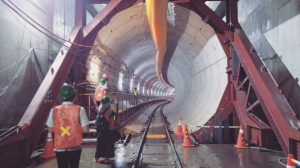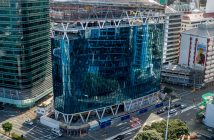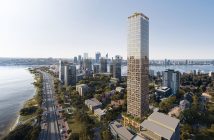
The complete MRT Jakarta project will stretch more than 110km and consist of two main lines: one north-south stretching 23.8km and an 87km east-west corridor
A slew of current and planned projects could transform the face of the region beyond recognition.
Asia is set for a huge infrastructure boost that has the potential to revolutionise the continent, a leading international observer believes.
“It could catapult some of the poorest economies in the region to the top of the list in terms of business investment,” says Jeremy Sheldon, Managing Director for Markets, JLL Asia Pacific.
The region has the advantage of developing modern infrastructure first time around rather than having to adapt old, outdated systems and facilities.
For example, cities such as Bangkok that were buckling under snarled road traffic have added modern mass-transit rail systems to ease the pressure and other capitals such as Jakarta are about to follow suit.
Traffic congestion costs Jakarta at least US$3 billion per year, Indonesia’s transportation ministry estimates. “So long as Jakarta doesn’t have a decent rail-based mass transportation system, we will always be congested,” admits Jakarta’s Governor Basuki “Ahok” Tjahaja Purnama.
It is needed desperately: between 2000 and 2010, the city’s population rose by 19 percent to some 10 million but the city’s area increased by 30 percent. Only 35 percent of Jakarta’s working population actually live in the city itself – some 1.4 million commute daily into the city.
All of that is set to change under new infrastructure plans for new toll roads, a railway line linking the airport and the city, and a light rail. “The net effect will transform Jakarta into a liveable city on par with Tokyo, Singapore and Hong Kong,” JLL Indonesia Managing Director Todd Lauchlan predicts. “From an underperformer, the city can lift itself well and truly into the 21st century.”
The Jakarta Mass Rapid Transit (MRT) project, which will cost in excess of $3 billion and be fully completed by 2030, aims to reduce congestion, improve quality of life and boost economic growth; not only in Jakarta but also across Indonesia.
The complete MRT Jakarta project will stretch more than 110km and consist of two main lines: one north-south stretching 23.8km and an 87km east-west corridor. Phase one of the north-south line is already under construction and is expected to be operational by 2018.
Meanwhile, phase two of the construction is expected to start just before the completion of phase one and is targeted for completion by 2020. The feasibility study for the east-west line is in progress, with construction expected to take place between 2024 and 2027 at the latest.
An airport connection, planned to open in 2020, would cut travel time to 30 minutes and allow travellers to check in downtown.
Separately, six new toll roads are also due to open by 2020, covering 72 kilometres, crossing the city like veins and pumping lifeblood into downtown. The benefits of these infrastructure improvements should be significant for Jakarta and Indonesia as a whole.
“Indonesia is behind neighbours such as Thailand and Malaysia in its urbanisation, which commentators say holds back growth,” says Laughlin.
Indeed, a recent Goldman Sachs calculated that Indonesia’s GDP would be 40 percent higher if it had matched the development of its neighbours such as Malaysia, the Philippines and Singapore.
Malaysian authorities have been praised for their foresight in mapping out an extensive long-term development plan that includes a high-speed rail link to Singapore, heavy investment in road, rail and ports, and an upgrade to Kuala Lumpur International Airport.
The Philippines has surged to the top as the world’s leading nation in terms of voice and data business process outsourcing, partly because of the development of Bonifacio as a central business district, the prospect of improved communications infrastructure, and initiatives such as the Clark Freeport Zone. A redevelopment of the old US Clark Air Force Base, the zone is being converted into an airport-driven trade and high-tech business hub.
Singapore leads the world in terms of infrastructure attractiveness, its US$156,000 per person the highest value per capita of built assets on the planet. It’s doubling the length of the Mass Rapid Transit system to 360 kilometres to boost its population from 5.5 million to 6.9 million by 2030. The city state is also adding a third runway and new airport terminals to Changi Airport and is changing the configuration of its port to double container capacity.
As Sheldon notes, these Asian nations are clearly anxious about how to provide employment and economic stability. “Infrastructure is one way of addressing that, and enhancing all people’s futures.”
Progress is well underway on the Jakarta Mass Rapid Transit (MRT) project, which will cost in excess of $3 billion and be fully completed by 2030
Strings attached?
Much of the Asian infrastructure financing comes from China, which appears to be using infrastructure as one of its most forceful foreign-policy tools.
The mainland has put up the bulk of the US$50 billion used to seed the Asian Infrastructure Investment Bank (AIIB), a US$100 billion lender that will make its first loan by the middle of 2016.
The AIIB will lend to projects involved in everything from energy and power, transport and telecoms, to rural infrastructure, water supply, environment protection and logistics, but is still pondering whether to finance coal-powered or nuclear plants.
Launched in October 2014, the bank has attracted 57 founding members, including New Zealand, which joined last December.
China’s coffers are funding two other significant initiatives. President Xi Jinping announced in November that China would invest US$40 billion to create the Silk Road Fund, an infrastructure and trade-finance initiative to extend its centuries-old trade route into central Asia.
The country has also helped set up the Shanghai-based New Development Bank, which was founded by the BRICS nations (Brazil, Russia, India, China and South Africa). They contributed US$100 billion to finance infrastructure projects in emerging nations and to improve the BRICS’ ability to withstand financial crises.
China also works directly with other emerging Asian nations. For instance, it is funding large-scale land reclamation in Colombo, Sri Lanka’s capital, and is also heavily involved in the creation of a massive port and the airport rebuild.



